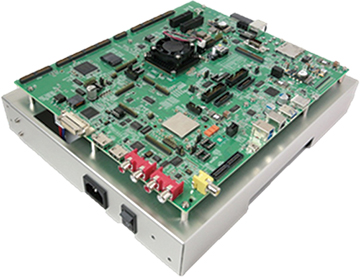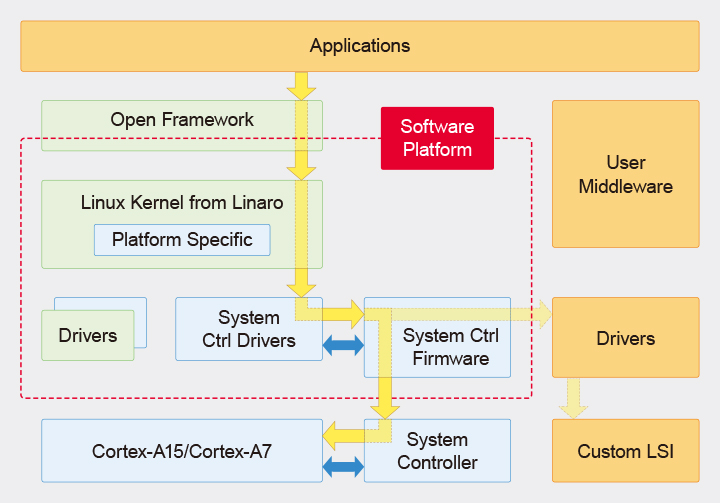A development evaluation board is provided for each PF SoC product. Since a Linux BSP is provided for each PF SoC product, customers can commence their development and evaluation immediately. We provide a semicustom board that can be used to evaluate custom LSIs using user logic by connecting it with a development evaluation board for PF SoCs. Approximately 15 million gates of user logic can be written on the FPGA installed on the semicustom board.

Platform Software
Solving challenges in system development, such as an increasing scale and performance improvement, requires enhanced software. For this reason, Socionext provides "platform software" (PF SW). This software increases the efficiency of software development by maximizing the performance of PF SoC, enhancing the reusability and performance portability of current software assets, and simplifying the introduction of third-party software.

Supporting the Use of the Standard Open Framework
Of software in embedded devices, PF SW belongs to the software layer that serves basic functionality, and supports the use of the Open Framework standard, including OpenGL and OpenCL, in addition to other software, including the drivers and firmware that control PF SoC and Linux Kernel.
Providing Common Software for All Product Series
Since common PF SW is provided for all PF SoCs, the compatibility of higher level applications is increased and reusability of current software is enhanced, which is effective in reducing development risks such as the development period and development costs. The same benefits can be also enjoyed with custom SoCs developed based on PF SoC.
Reducing the Burden of System Development
Pieces of software related to specific functions, including the processing function related to system control, the security function, and the network standby and response function, are consolidated into the System Controller Firmware (SCFW). Applications control the SoC through this firmware. PF SoC users can reduce the burden of developing relevant functions by using this firmware which functions together with Linux and shift their resources to application development. For example, to transition SoC to power saving mode, applications use a general Linux framework. In a lower layer, however, Linux and SCFW operate in close cooperation. This enables state transition without requiring application developers, in particular, to be aware of the SoC power supply or clock control functions. SCFW also assumes control of resumption from power saving mode. Linux and SCFW share the role of controlling SoC, which enables more robust systems and flexible extension and customization of hardware. This minimizes the impact on the kernel or BSP when a new custom SoC is developed and makes it possible to quickly obtain the PF SoC and other software that operate the SoC.
Future Plans
In the future we will increase the availability of middleware and expand the scope of support for embedded OSs and other software while aggressively promoting the use of open source software and collaboration with our partners. In addition, as a method for simplifying the power control of an entire system, we at Socionext will provide a unique solution that will seamlessly manage the power of custom LSIs as well as PF SoCs from an application on Linux.



